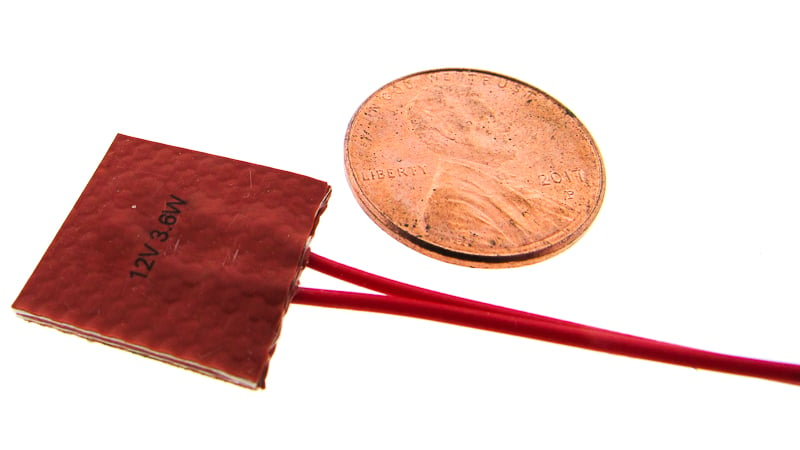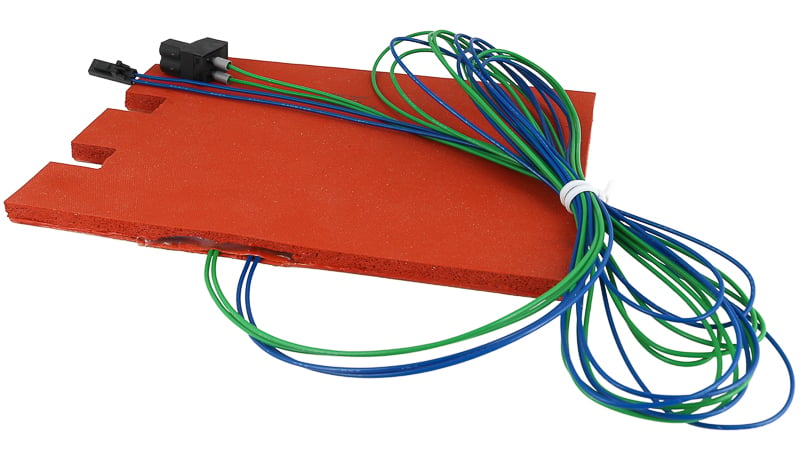When applications and products require heating options, polyimide and silicone rubber flexible heaters are ideal for a wide range of uses. With optimal heat transfer, they can provide the right temperatures for electronics, instrument panels, sensors, medical devices, and food service products.
While we often think about flexible heaters in standard shapes such as rectangle, square, and round, customized flexible heaters can be designed in a wide variety of shapes and have the appropriate cutouts to go around component objects, such as pipes and inserts. They may also be designed with different temperature zones for places that don't require to be heated or may generate their own heat.
Dimensional Capabilities and Limitations
When it comes to the overall sizes of silicone and polyimide flexible heaters, the sizes will be entirely based on the type of resistant elements that are used. Etched foil elements offer the thinnest flexible heaters available, as they can be used in both silicone and polyimide materials. This element is perfect for smaller flexible heaters, as the heater can be designed to be as small as 1" x 1" to as large as 10" x 70" for polyimide, and as large as 18" to 24" for silicone rubber. If larger sizes are needed, wire wound resistant elements would be more appropriate.

Example of a small flexible heater the size of a penny.
For shapes, odd and non-symmetrical flexible heaters can be accomplished when using an experienced manufacturer such as Epec. Based on the specific needs of the application, mechanical equipment and laser cutters will be utilized with an outline of the desired shape. Internal cut-outs in circular, square, rectangular, and other shapes can also be provided without impacting the heating capabilities and reliability of the flexible heaters.
Be advised that there may be a delay in heat transfer when using wire wound elements. Etched foil elements allow for faster warmup and thermal transfer for both silicone and polyimide heaters. Wire wound is not available for polyimide heaters.
Multiple Heating Zones
Not every application requires to be heated throughout the surface. For example, electronics may have places where the circuitry itself creates the required heat and is fully protected from other internal or exterior temperature changes. Applying additional heat to this area is not recommended. However, the area surrounding these electronics require more temperature control. In these circumstances, cut-outs along the heater material would be ideal. Yet what about instances where heating is required, but at different temperatures?
Applications such as this can also benefit from a polyimide or silicon flexible heater. If all the electronics need to be heated, yet some areas at a lower temperature due to the fragility of the materials that are present in the application, then multiple heating zones can be provided.
When thinking about multiple heating zones, the first thought that comes to mind is having individual heaters in each section that will be controlled manually or automatically by different controls. In reality, there are many other options as one flexible heater and controller can be used. The flexible heater will have specific characteristics and layouts when providing different temperatures. Some options involve varying the width and compression of the heating element (conductors).
Variable Conductor Widths
For foil etched heaters, the width of the conductors will impact the watt density in certain areas of the flexible heater. When the conductor width is thinned out, it decreases the thermal output in that area. This conductor width variance does not have to occur in specific areas, such as where the input power lines are located. Instead, the width variance can be selected anywhere as we will customize the conductors to your specifications.
Conductor Compression
Another way to provide varying temperatures within one flexible heater is to compress or stretch out the conductor within the thermal pattern while keeping the same conductor width. By compressing the conductor path so that it is closer together, this pattern increases the thermal output. To lower the amount of heat provided by the etched foil elements, more space can be introduced within the conductor pattern. This feature can be offered with both foil etched and wire wound resistor elements.
Multiple Input Lines
Multiple input lines may be another method to provide several heating zones. This option is ideal for larger heaters that will be constantly monitored and have the temperature adjusted with separate controllers. By intentionally designing the heater with several input lines, more control can be given to the operator for applications that are sensitive to heat fluctuations to ensure the right temperature is given at all times when a single flexible heater will be in use. It also assists with minimizing design iterations with the heater, as the same conductor width and spacing will be used throughout the surface.

Example of a silicone flexible heater with multiple input lines.
Issues to Be Aware of with Multiple Zone Heaters
Multiple zone flexible heaters provide a wealth of benefits to numerous industries. Yet there are some circumstances that customers should be aware about when selecting the type of materials, resistor elements, line inputs, and configurations.
Loss of Heat Around Cut-Outs
The top issue is providing uniform heat distribution when cut-outs are needed within the flexible heater. In one case, there may be round holes near the edges of the heater. Based on how the conductor pattern is placed, there may end up being thermal variances in places that are more isolated along the heater due to the placement of the round cut-outs.
To avoid this issue, the thermal conductor pattern must be redesigned. In the isolated areas, the conductor width or spacing may be increased. This strategy allows for more thermal heat to move into those other places to compensate for the potential heat loss. The flexible heater will now provide a more even temperature distribution without the need for additional heaters to be placed into the isolated areas.
Material Incompatibility
Certain applications may experience harmful environmental factors, such as excess corrosion, chemical intrusion, or magnetic fields. A customer needs to further define the types of adverse conditions that may be experienced with the application that could impact the operability of the flexible heater.
For one instance, the flexible heater may be used in an environment that may be prone to magnetic interference and vibrations. A nickel-chrome nonmagnetic alloy used for the etched foil element in a silicone rubber heater can be used as this heater will provide the appropriate even temperature and will also be durable enough to withstand vibrations and shocks.
In another circumstance, chemical acids may be present in the environment and will collect on the surface where the flexible heater will be mounted. Silicone rubber has a good chemical resistance. However, the rubber material can be negatively impacted by certain acids such as phosphoric acid or sulfuric acid. The rubber can also experience corrosion from mineral oils, motor oils, and benzene. Another material, such as polyimide, may be more suitable in these applications.
Getting the Multiple Zone Heater for Your Preferences
One thing to keep in mind is that a customer does not need to select several heaters to get the desired temperature for the application. Instead, a customer should focus on the size, width, and desired watt density that is required. Based on these factors, the flexible heater manufacturer can create one flexible heater based on these specifications while varying the thermal pattern to provide the adequate temperature flow rate. In fact, our engineers can create different heater designs that all provide the same wattage simply be modifying the conductor width and conducive pattern.
How many input lines, the number of controllers, and other factors will be entirely based on the application and the desired temperature range. Providing these design specifications to our engineers during the initial project discussion can allow us to design the appropriate flexible heater with minimal changes or modifications. Then you can have better production line and turn-around times for your application's time-to-market deadlines.
Summary
Your application requires the right heating in adverse environments to deal with extremely cold temperatures, moisture, and condensation buildup while allowing components to function properly. Here at Epec, we design and manufacture both silicone and polyimide heaters for a wide range of industries including medical, food, aerospace and military defense.
With our state-of-the-art technologies and dedicated engineers, we work with customers to determine the right heaters that will do the job. In addition, we also offer material and wattage suggestions that can provide even more cost-savings for our customers while ensuring that the heater will provide the even temperature for the entire time that it will be placed into use.
Key Takeaways
- Custom shapes and cutouts: Flexible heaters can be designed in non-standard shapes with cutouts around components, enabling tailored heating without compromising performance.
- Multiple heating zones in one heater: Instead of separate heaters, varying conductor widths, compression, or multiple input lines within one flexible heater allow different areas to run at different temperatures.
- Conductor design impacts heat output: Narrower conductors or compressed conductor patterns increase watt density, while wider spacing lowers heat in selected zones.
- Material compatibility is critical: Silicone rubber and polyimide each have unique strengths and weaknesses; selecting the right material ensures durability against environmental factors like chemicals, vibration, or moisture.
- Uniform heat around cutouts requires design adjustments: To avoid cold spots, conductor patterns must be modified to balance temperature distribution across isolated areas of the heater.
















